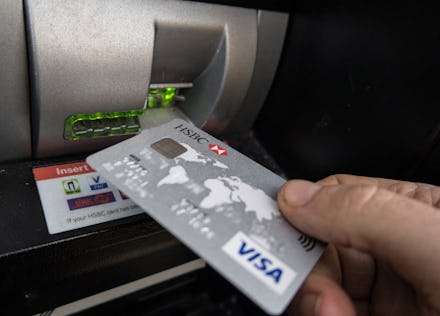Here's what a credit or ATM card skimmer looks like — and the one trick to use to protect yourself

Did you know that your credit card information and — worse! — your debit card account details can be accidentally compromised by your own hand?
The second you unwittingly put your card into a machine with a skimmer attached, you've opened up your wallet to the dark side.
That's why knowing how to spot a skimmer (and what telltale signs to look out for) can help you protect your money.
You also need to be aware which machines are most likely to have skimmers — and to remember which cards to use in more precarious circumstances.
Here's how to shield your hard-earned cash from a skimmer-happy scammer.
What is a card skimmer, exactly?
A skimmer is a device that thieves attach to an ATM or a payment machine to trick people who are swiping their credit cards or debit cards.
The device attaches to (or over) the space where your card is normally inserted, and reads the information — which thieves then can use to compromise your accounts, according to the U.S. Department of the Treasury.
Often, if the target is debit cards, the skimming device is set up on the ATM, along with a nearby camera or person watching you enter your PIN.
Shoppers can also victimized, with fake "overlay" pieces fitted over real payment machines at stores.
If they steal your debit card information and your PIN, fraudsters have everything they need to wipe you out — or make their money by selling your data to the next thief down the line.
What does a card skimmer look like?
One giveaway that you might be at risk is if a terminal looks especially wide — since any overlay skimmer piece will inevitably take up extra space.
Another suspicious giveaway is if the keypad backlight is off.
And a third weirdness to watch out for is if your card goes so deep into a chip reader than you can't keep a thumb on it. Those are possible signs of a scam.
Indoor ATMs within your bank are not impervious to skimmers, but given the constant presence and supervision of bank employees, they are less likely to become compromised or remain compromised for an extended period of time.
In general, if a card reader looks suspicious, you should shake it, pull on it and wiggle it: If there is a skimmer attached, you may be able to reveal it.
And always cover your hands when entering in your PIN — even if it appears that no one is watching.
You never know where a camera could be hiding, and even if someone gets ahold of your card information, they can't get far without your PIN.
Should I use my credit card or debit card?
Skimmers are often found at outdoor ATMs or payment machines.
You might also be careful with card-swiping slots at gas pumps, vending machines, at airports, or malls.
When you have the option, although some people pay with credit cards and debit cards interchangeably, you shouldn't.
When in doubt, use a credit card, and keep that debit card in your pocket.
Remember, the very quality that makes debit cards so appealing — the ability to limit your spending to only money you have in your account — also makes them dangerous in these situations.
That debit card is likely linked to your checking account, meaning anyone else who has that card can spend all of what you have.
Alternatively, a compromised credit card, while a major headache, is not as devastating as a stolen debit card. You just report the theft to your credit card company as soon as possible — and by law your losses will never be more than $50, no matter how much a thief steals.
Sign up for The Payoff — your weekly crash course on how to live your best financial life. Additionally, for all your burning money questions, check out Mic’s credit, savings, career, investing and health care hubs for more information — that pays off.